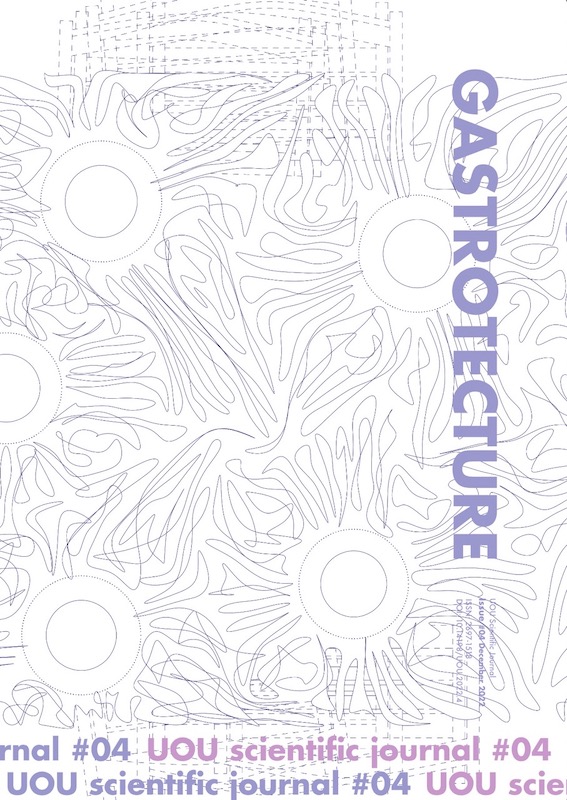Architecture for Fermentation and vice versa.
Abstract
The climate change and the consequent rising temperatures are evident, and solutions that respect the environment, the society and economy are needed. Human population has raised until a point in which those solutions were designed to place humans in first position. A demonstration of this fact lies on our own home designs, they have been improved by knowledge donations from many disciplines, between them, architecture. Several passive-cooling techniques comes from this discipline and might help to enrich the portfolio of some others that will be affected by the same issue of temperatures. Fermentation is an ancient technique that has evolved until our days, and it means approximately 1/3 of our culinary diversity. Fermentation, like architecture, relies on the design of semi-isolated environments that facilitates certain kind of life: microscopic, macroscopic or both. Assuming that the rising temperatures affects the stability of life, same rising-temperatures’ challenge is shared by both architecture and fermentation and the cross-contamination of passive cooling techniques in a multi, inter and even transdisciplinary way might create new solutions for both and many other disciplines. To this end, this review proposes as a hypothetical experimental model, the Iberian pork slaughterhouse, a space designed to host both human and microbial life, and which will therefore also be affected by the increase in temperature. Future studies are therefore proposed to test the hypotheses put forward in this review.
Downloads
References
ATTIAS, Noam, et al. Mycelium bio-composites in industrial design and architecture: Comparative review and experimental analysis. Journal of Cleaner Production, 2020, vol. 246, p. 119037.
AYAVIRI NINA, Dante; VALLEJOS MAMANI, Pedro. Cambio climático y seguridad alimentaria, un análisis en la producción agrícola. JOURNAL de CIENCIA y TECNOLOGIA AGRARIA, 2014, vol. 3, p. 59.
BALL, Clara Sue. The early history of the compound microscope. Bios, 1966, p. 51-60.
BATTCOCK, Mike. Fermented fruits and vegetables: a global perspective. Food & Agriculture Org., 1998.
BECHTEL, William. Philosophy of science: An overview for cognitive science. Psychology Press, 2013.
BLOCKSTEIN, David E. Landscape Linkages and Biodiversity. BioScience, 1992, vol. 42, no 9, p. 712-715.
BUGENINGS, Laura Annabelle; KAMARI, Aliakbar. Bioclimatic Architecture Strategies in Denmark: A Review of Current and Future Directions. Buildings, 2022, vol. 12, no 2, p. 224.
CAÑAS, Ignacio; MARTÍN, Silvia. Recovery of Spanish vernacular construction as a model of bioclimatic architecture. Building and Environment, 2004, vol. 39, no 12, p. 1477-1495.
CLARK, J. Desmond; HARRIS, John WK. Fire and its roles in early hominid lifeways. African Archaeological Review, 1985, vol. 3, no 1, p. 3-27.
CRUZ VARONA, Alejandra. Control de especies de" Fusarium" productoras de fumonisinas: factores ecofisiológicos y cambio climático. 2016.
FATHY, Hassan. Natural energy and vernacular architecture. 1986.
GOWLETT, John AJ. The discovery of fire by humans: a long and convoluted process. Philosophical Transactions of the Royal Society B: Biological Sciences, 2016, vol. 371, no 1696, p. 20150164.
GRISMER, Mark E.; SHEPHERD, Heather L. Fermentation industry. Water environment research, 1998, vol. 70, no 4, p. 637-642.
HANSSON, Sven Ove. Philosophy and other disciplines. Metaphilosophy, 2008, vol. 39, no 4‐5, p. 472-483.
HARIBABU, Ejnavarzala. Social construction of Biotechnology. In Basarab Nicolescu (Ed.), Transdisciplinarity, Theory and practice Hampton Pr, pp. 2010, 191–200 India
HAYS, Stephanie G., et al. Better together: engineering and application of microbial symbioses. Current opinion in biotechnology, 2015, vol. 36, p. 40-49.
HE, Jiang; HOYANO, Akira. Experimental study of cooling effects of a passive evaporative cooling wall constructed of porous ceramics with high water soaking-up ability. Building and environment, 2010, vol. 45, no 2, p. 461-472.
HEDEGAARD, Liselotte. Gastronomy and science: Terminological conundrums. International journal of gastronomy and food science, 2019, vol. 15, p. 22-25.
JAIN, Dilip. Modeling of solar passive techniques for roof cooling in arid regions. Building and Environment, 2006, vol. 41, no 3, p. 277-287.
JAMES, W. P. T., et al. Nutrition and its role in human evolution. Journal of internal medicine, 2019, vol. 285, no 5, p. 533-549.
KAMAL, Mohammad Arif. An overview of passive cooling techniques in buildings: design concepts and architectural interventions. Acta Technica Napocensis: Civil Engineering & Architecture, 2012, vol. 55, no 1, p. 84-97.
KATZ, Sandor Ellix. Fermentation as metaphor. Chelsea Green Publishing, 2020.
LEE, Kwang Soo, et al. Quality evaluation of Korean soy sauce fermented in Korean earthenware (Onggi) with different glazes. International journal of food science & technology, 2006, vol. 41, no 10, p. 1158-1163.
LERA, Rita María Sánchez; GARCÍA, Ninfa Rosa Oliva. History of the microscope and its repercussion on Microbiology. Humanidades Médicas, 2015, vol. 15, no 2, p. 355-372.
MANZANO-AGUGLIARO, Francisco, et al. Review of bioclimatic architecture strategies for achieving thermal comfort. Renewable and Sustainable Energy Reviews, 2015, vol. 49, p. 736-755.
MCGREGOR, Sue LT. Transdisciplinarity and conceptual change. World Futures, 2014, vol. 70, no 3-4, p. 200-232.
MEKHILEF, Saad; SAIDUR, Rahman; KAMALISARVESTANI, Masoud. Effect of dust, humidity and air velocity on efficiency of photovoltaic cells. Renewable and sustainable energy reviews, 2012, vol. 16, no 5, p. 2920-2925.
NICOLESCU, Basarab; ERTAS, Atila. Transdisciplinary theory and practice. USA, TheATLAS, 2008.
NICOLESCU, Basarab. Manifiesto de la transdisciplinariedad (Transdisciplinarieté). Multiversidad Mundo Real Edgar Morin, AC https://basarab-nicolescu. fr/BOOKS/Manifeste_Espagnol_Mexique. pdf, 1996.
NICOLESCU, Basarab. Methodology of transdisciplinarity. World Futures, 2014, vol. 70, no 3-4, p. 186-199.
NICOLESCU, Basarab. Transdisciplinarity and sustainability. Edited by Basarab Nicolescu. Lubbock, Texas: TheATLAS Publishing, 2012.
PALOMAR AGUILAR, David. Sistema constructivo: panel para fachada ventilada con mini aljibe, para enfriamiento evaporativo pasivo estacional. 2017. Tesis Doctoral. Arquitectura.
PARRA MARCOS, Patricia. La cuna del jamón ibérico. Desarrollo de un pueblo en torno a una industria. 2020.
PISARNITSKII, A. F. Formation of wine aroma: Tones and imperfections caused by minor components. Applied Biochemistry and Microbiology, 2001, vol. 37, no 6, p. 552-560.
PRETORIUS, Isak S.; DU TOIT, Maret; VAN RENSBURG, Pierre. Designer yeasts for the fermentation industry of the 21st century. Food Technology and Biotechnology, 2003, vol. 41, no 1, p. 3-10.
RAJKOVIĆ, Katarina M., et al. Aspergillus fumigatus branching complexity in vitro: 2D images and dynamic modeling. Computers in Biology and Medicine, 2019, vol. 104, p. 215-219.
ŠÁL, Jiří; NOVÁKOVÁ, Petra. Increase the porosity of the brick block using fermentation residues. International Multidisciplinary Scientific GeoConference: SGEM, 2018, vol. 18, no 6.3, p. 251-256.
SCHIANO-PHAN, Rosa. The development of passive downdraught evaporative cooling systems using porous ceramic evaporators and their application in residential buildings. 2004. Tesis Doctoral. Architectural Association.
TERRADOS-CEPEDA, F. J.; BACO-CASTRO, L.; MORENO-RANGEL, D. Patio 2.12: prefabricated, sustainable, self-sufficient and energy efficient house. Participation in the 2012 Solar Decathlon Competition. Informes de la Construccion, 2015, vol. 67, no 538.
TODARO, Celeste C.; VOGEL, Henry C. (ed.). Fermentation and biochemical engineering handbook. William Andrew, 2014.
VIOLA, Pasquale. La contribución científica del Intergovernmental Panel on Climate Change al Pacto Verde Europeo: introducción a la European Climate Law. A&C-Revista de Direito Administrativo & Constitucional, 2020, vol. 20, no 81, p. 55-68.
WINN, KELLY. Prototyping Digital Ceramic Lattice Structures.
Downloads
Published
How to Cite
Issue
Section
License
Copyright (c) 2022 José de la Rosa Morón

This work is licensed under a Creative Commons Attribution 4.0 International License.
The authors keep their rights upon their work, although they transfer, in a non-exclusive way, the rights of exploitation (reproduction, publication, distribution, public dissemination and presentation) to the Journal. The authors are, therefore, free to enter additional, separate contracts for the non-exclusive distribution of the version of the work published in the Journal (for instance, by hosting in an institutional repository or publication in a book), provided credit is given that the work was initially published in this journal. The works are published under a Creative Commons Attribution 4.0 (CC BY 4.0) license.












